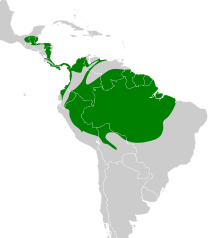| This article needs additional citations for verification. Please help improve this article by adding citations to reliable sources. Unsourced material may be challenged and removed. Find sources: "Ruddy-tailed flycatcher" – news · newspapers · books · scholar · JSTOR (February 2023) (Learn how and when to remove this message) |
| Ruddy-tailed flycatcher | |
|---|---|

| |
| at Rio Branco, Acre state, Brazil | |
| Conservation status | |
 Least Concern (IUCN 3.1) | |
| Scientific classification | |
| Domain: | Eukaryota |
| Kingdom: | Animalia |
| Phylum: | Chordata |
| Class: | Aves |
| Order: | Passeriformes |
| Family: | Tityridae |
| Genus: | Terenotriccus Ridgway, 1905 |
| Species: | T. erythrurus |
| Binomial name | |
| Terenotriccus erythrurus (Cabanis, 1847) | |

| |
The ruddy-tailed flycatcher (Terenotriccus erythrurus) is a small passerine bird in the family Tityridae. It breeds in lowlands from southeastern Mexico to northern Bolivia, north-central Brazil and the Guianas. This flycatcher ranges east of the Andes cordillera into the entire Amazon Basin of northern Brazil and the Guianas; to the west of the Andes in Colombia and Ecuador into Central America. It is the only member of the genus Terenotriccus, but some authorities place it in genus Myiobius. However, it differs in voice, behaviour, and structure from members of that group.
This tiny flycatcher breeds from sea level to 1,000 m (3,300 ft) altitude, locally to 1,200 m (3,900 ft), in wet mountain forests and in adjacent tall second growth. The nest is a pear-shaped pouch of plant fibres and leaves with a visored side entrance, built by the female 2–6 m high in the undergrowth and suspended from a twig or vine. The two chocolate-blotched white eggs are incubated by the female for 15–16 days to hatching, the male playing no part in the care of the eggs or young.
The ruddy-tailed flycatcher is 9.0–10.2 cm (3.5–4.0 in) long and weighs 7 g (0.25 oz). The upperparts are grey-olive, with a rufous rump, tail, wings and eye ring. The throat is buff and the breast is cinnamon, becoming pale buff on the belly. Sexes are similar, but young birds are brighter above and have a browner tail and breast.
The ruddy-tailed flycatcher is mainly solitary, and only occasionally joins mixed-species feeding flocks. It feeds on insects, especially leafhoppers, picked from foliage or taken in acrobatic aerial pursuit.
This species has a see-oo see call, and a repetitive eek eek eek eek eek song. It sometimes flicks both wings up to make a faint whirring sound.
References
- BirdLife International (2016). "Terenotriccus erythrurus". IUCN Red List of Threatened Species. 2016: e.T22699711A93744629. doi:10.2305/IUCN.UK.2016-3.RLTS.T22699711A93744629.en. Retrieved 12 November 2021.
Further reading
- Skutch, Alexander F. (1960). "Ruddy-tailed flycatcher" (PDF). Life Histories of Central American Birds II. Pacific Coast Avifauna, Number 34. Berkeley, California: Cooper Ornithological Society. pp. 534–538.
External links
| Taxon identifiers | |
|---|---|
| Terenotriccus erythrurus |
|
| Terenotriccus | |
